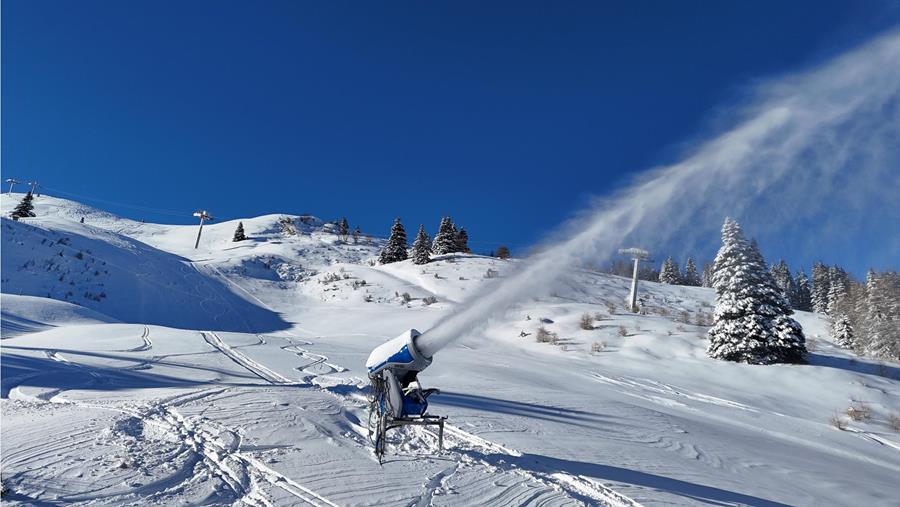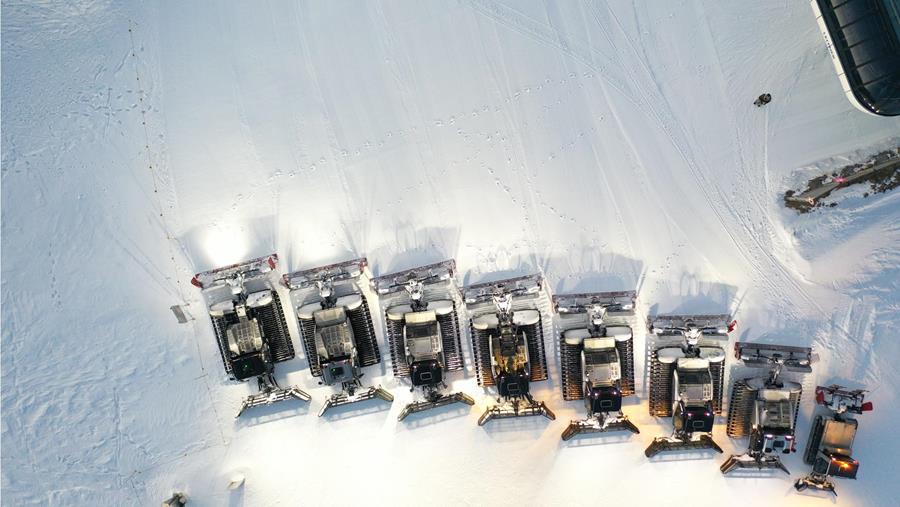Passionate winter sports enthusiasts often wait eagerly for the first snow. And it's not just them. The magic of freshly fallen snow is hard to resist.
Few people know as much about snow as the experts in the ski resorts of Ratschings-Jaufen, Ladurns, and Rosskopf. After all, snow is their specialty. They are well-versed in the properties and characteristics of different types of snow, from the light, fluffy powder snow to the crusty, hard-frozen snow and even technical snow, which is what artificial snow is correctly called. One thing is clear now: Even in snowy winters, artificial snowmaking is essential for well-prepared slopes.
Water + Air + Cold Temperatures = Snow

Snow is made of water and air. The principle is simple and the same for both natural and artificial snow. Tiny water droplets freeze and turn into snow crystals. Each snowflake is a small, delicate work of art, made up of uniquely shaped, hexagonal ice crystals. Artificial snowflakes look different: they are round. Snow cannons and snow lances cool water and compressed air to the ideal temperature and blow a mixture of air and water outside. Immediately, small round ice crystals form in the cold air, to which more tiny water droplets adhere and freeze – the artificial snowflake is created. Snow cannons have a greater range than snow lances, making them ideal for large-scale slope snowmaking, while snow lances, with their shorter range, are mainly used for creating snow on ski paths. No chemical substances are used in the production of snow.
When is the Ideal Time to Make Snow? At this point, it becomes clear that the process of making artificial snow is more complex than initially thought. Two factors need to come together: temperature and humidity. "The key factor in snow production is the wet-bulb temperature, which is the relationship between temperature and relative humidity," explains Anton Obex, who is responsible for the slopes at the Ratschings-Jaufen ski resort. "As a rule of thumb, light sub-zero temperatures and humidity levels below 80 percent are ideal for snowmaking." The drier the air, the higher the surrounding temperature can be. This means, conversely, that in dry air, snow cannons can also create snow even when the temperature is zero degrees.
Thinking About Winter in Summer

The preparation for the upcoming winter begins early in the ski resorts – usually with the maintenance of the snowmaking system. Nozzles are cleaned, and hoses are checked. By now, most snowmakers in the ski resorts are permanently installed: they are supplied with electricity and water through underground cables and pipes, controlled automatically, and covered with protective covers during the summer. Mobile snow cannons, on the other hand, are stored in the summer. In winter, they have the advantage of being transportable by snow groomers to wherever they are needed.
But thinking about winter also means being open to innovation. "We invest in our snowmaking system every year," says Paul Eisendle, President of "Neue Rosskopf GmbH", highlighting once again how important powerful and efficient snowmakers, along with modern technology, are for ski resorts. "Many of the snowmakers in use now operate using their own pressure – which has a positive effect on electricity consumption." Environmental protection, sustainability, and resource-efficient operations are topics that have long been integrated into ski resorts.
With and Without "Frau Holle's" Help
To ensure that everything is perfectly prepared for the start of the winter season, snowmaking on the slopes begins in November. Technical snow is very compact and forms a stable base layer for the ski slopes. With a density of 300 to 500 kilograms per cubic meter, it is much heavier than natural snow (natural snow: 10 to 80 kilograms), melts more slowly, and forms fewer bumps during skiing.
The most important resource for snow production – water – comes from reservoirs, streams, and springs in all three ski resorts. "A snow cannon uses at least 0.8 liters of water per second," says Anton Obex. In Ratschings-Jaufen, the largest ski resort in the Wipptal valley with 28 kilometers of slopes, the reservoir holds around 62,000 cubic meters of water, with two smaller storage lakes in addition. "A strictly regulated amount of water can be drawn from the springs and the stream," Anton Obex adds.

The situation is similar at Rosskopf and Ladurns. "Our reservoir at the top of the mountain holds 22,000 cubic meters of water," explains Paul Eisendle, "and we also draw water from the Eisack river, which is pumped up." At the end of the ski season, the sun is allowed to do its work at Rosskopf, and the ski slopes slowly begin to melt. The water flows back into the Eisack, completing the cycle. Around 20 kilometers of slopes and the toboggan run are covered with snow at Rosskopf.
Michael Hochrainer, the operations manager of the Ladurns ski resort, knows exactly that the 55,000 cubic meters of water in the reservoir are not enough to cover the 18 kilometers of slopes. For the snowmaking on the valley descent, he can additionally rely on water from a small spring. "Because the reservoir is higher than the slopes, we can cover two-thirds with natural pressure, but for one-third, the water has to be pumped uphill." There’s also a special feature in the Ladurns ski resort: "The water pipe that transports spring water for snowmaking on the valley descent in winter powers a small hydroelectric plant in spring, summer, and fall."
"Of course, natural snow is welcome," Paul Eisendle clarifies, dispelling a common misconception. "Natural snow helps any ski resort." And it does so in multiple ways. First, it increases the existing snow amount, as it blends seamlessly with the technical snow. Secondly, it turns every ski resort into an enchanting winter landscape – for a unique winter experience.
Speaking of Slope Preparation

Whether technical snow or natural snow – slopes are prepared daily throughout the ski season. As dusk falls, the men drive their loud, powerful snow groomers out of the garage, steer the massive "snow cats" over the steep slopes, and push snow back and forth. But certainly not haphazardly! Snow that has been pushed to the edges of the slope by skiing needs to be brought back onto the slope, and not just any old way, but evenly distributed. The workers don’t have much time for this, as the job must be completed by midnight at the latest to allow the snow layers to bond together.
Modern technology is also used here. "Only this year have we equipped all snow grooming vehicles with snow height measuring devices," says Michael Hochrainer. "They measure the thickness of the snow cover and thus help in preparing the slopes." But that's not all: The measured data shows whether and where more snow should be made to guarantee uninterrupted skiing enjoyment. Precisely.
As wonderful as natural snow is, in many places, winter sports would simply no longer be possible without artificial support. With impressive precision and a lot of high-tech, ski resorts are responding to climate change and producing snow as sustainably as currently possible. Because one thing is certain here: snow is precious.
Text: Johanna Bampi